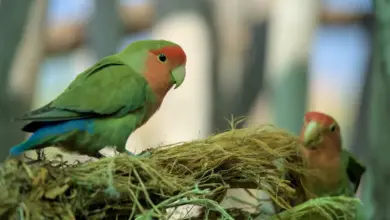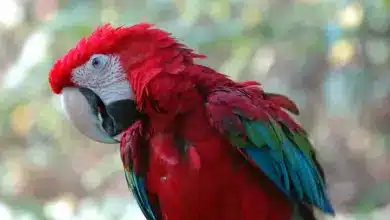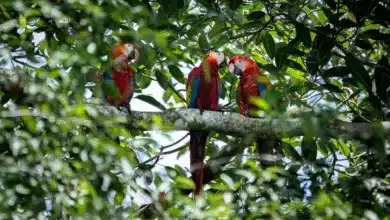Parrots: The Colorful World Of The Psittaciformes
Parrots (Psittaciformes)
Parrots (Psittaciformes) are a medium sized order of birds of similar and distinctive shape.
The order contains 360 species in 80 genera all of which are contained within a single family, the Psittacidae.
Parrots are a very popular group of birds. Their colorful patterns and cute mannerisms – including picking things up with their feet and climbing with their bills – endears them to us all.
The budgerigar is one of the most popular pets in the world and several other species of parrot enjoy popularity because of their ability to mimic human speech.
In fact, a number of species of parrot are endangered in the wild because of excessive trapping for the pet trade. Ultimately, though they make wonderful long-lived pets – although parrots like all birds are best seen flying wild.
Parrots range in size from 8-10 cm (3-4 ins) to 1 metre (40 ins) in length.
The smallest is probably the Buff-faced Pygmy Parrot, Micropsitta pusio from Papua New Guinea. The largest is the Hyacinth Macaw (Anodorhynchus hyacinthinus)from S. America.
Parrots are distinctive in that the upper mandible of their bill is hinged at the joining to the skull, which gives it more manoeuvrability than in other birds. The arrangement whereby the lower jaw mandible fits up under the top one is also distinctive.
This – and in most species a thick muscular tongue – allow parrots to manipulate food items easily in their mouths. The exceptions to the short thick tongue are the Lories and other nectar feeding parrots, which have longer, thinner tongues adapted for collecting nectar and pollen from flowers.
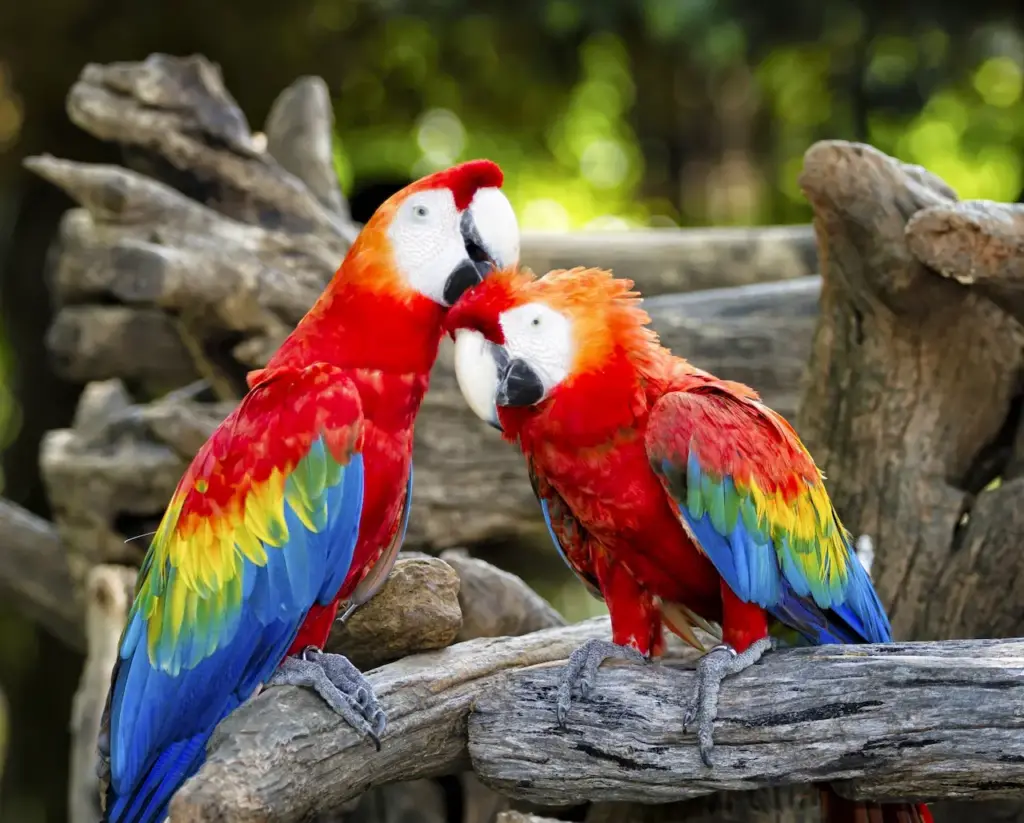
Most species feed on fruit and seeds, though some species will feed on insects as well. Black Cockatoos for example feed extensively on wood-boring beetle larvae.
The strangest feeding habit among parrots is that of the Kakapo, Strigops habroptilus, of New Zealand which feeds by chewing on leaves which are still attached to the plant. It sucks the juices out of the chewed up leaves, leaving a ball of chewed leaf behind still attached to the plant, making it easy to know where one has been feeding.
Another New Zealand parrot, the Kea has been given a bad name in common myth as a killer of sheep. There is, however, no scientific evident to support this accusation – though it is known to feed on carrion if given the opportunity.
Most parrots are forest birds, living in small groups or as individual pairs or families. Species that live in open grassland, however, tend to aggregate in larger flocks and up to an estimated 1,000,000 budgerigars have been recorded in a single flock in Australia.
The majority of parrots live in the tropics and the southern hemisphere, with Australasia and S. America having the greatest number of species. The now extinct Carolina parakeet, Cornuropsis carolinensis, had the most northerly distribution – it occurred in N. America as far north as the Great Lakes.
The most northerly parrot now is the Slaty-headed parakeet, Psittacola himalayana, from eastern Afghanistan. The Ring-necked or Rose-ringed parakeet Psittacula krameri exists as a feral population in places in Europe, including the UK, but this is far north of its natural distribution. The most southerly distributed parrot is the Australian Conure, Enicognathus ferrugineus.
Most parrots are monogamous and form strong pair bonds which in some cases last for life. Which can be a considerable number of years, especially in larger species…
The age record for a bird is held by a Cockatoo, with an officially accepted age of at least 82 years!
Nearly all parrots make simple unadorned nests in holes in trees. Often these contain no lining material at all, except perhaps some wood chips resulting from the adults’ hole enlarging activities.
Some species such as the commonly kept Love Birds (genus Agapornus) and the Hanging Parakeets, build complete nests – transporting nesting material by stuffing it into the feathers on their rumps.
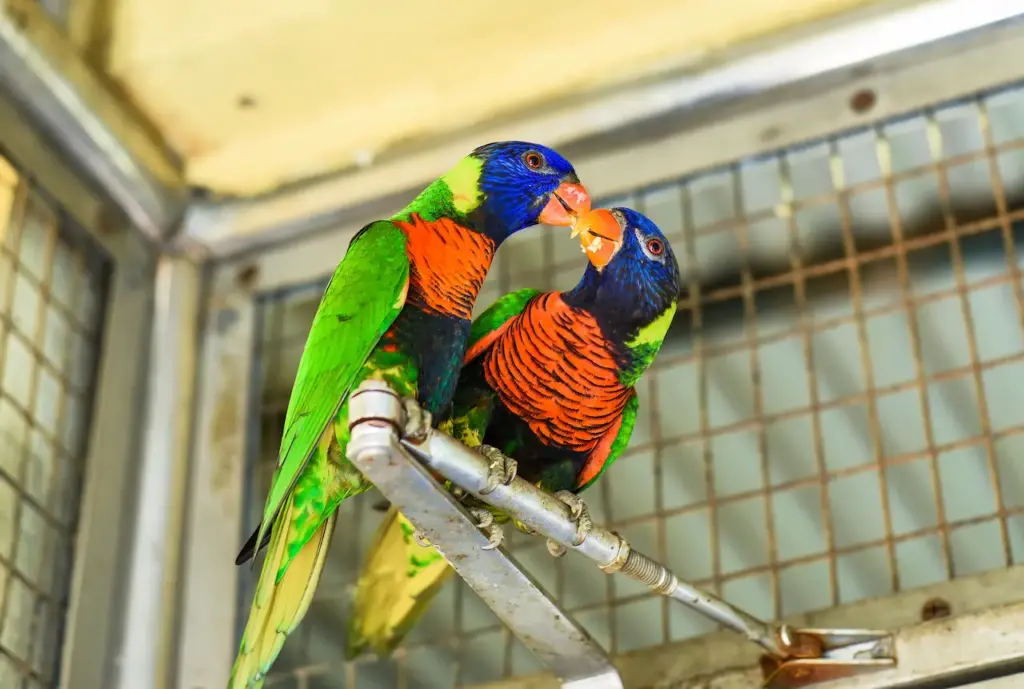
Of the few species that do not nest in holes in trees, most nest in holes in grass tussocks – though the Conures of S. America excavate holes in the sides of cliffs. The Monk parakeet Myiopsitta monarchus from S. America, builds a large communal nest of twigs, within which each participating pair has its own separate nest.
For the monogamous species, courtship is generally simple involving a few bowing, eye blinking and wing flexing manoeuvres.
Species like the polygamous Kea, Nestor notabilis, and the leking Kakapo, Strigops habroptilus, obviously behave differently. Like all leking species of bird, male Kakapo parrots of New Zealand gather at a certain spot and display with certain calls. Females attend the lek, where they choose a mate and after copulation leave to build a nest and raise the young on their own.
Parrots lay 2 or 3 eggs in most cases, though up to 5 may be laid in some cases. Like all hole nesting species, the eggs are white and almost spherical. The young are ‘altricial’ meaning that they hatch with few or no feathers, except a fine down and are totally dependent on their parents for food and protection for some weeks before they can leave the nest.
In many species the young are fed by the adults for some time even after leaving the nest.

Alexandrine Parakeet (Psittacula eupatria)
The time taken for the eggs to hatch, the young to ‘fledge’ (achieve a full set of feathers) and then to reach sexual maturity varies between species.
Generally, the larger the bird the longer each of these stages takes. Thus small parrots like the budgerigars take about 18 days to hatch, 30 days to fledge and just a year to reach sexual maturity. While in larger species like Black Cockatoos and Macaws, incubation can take 35 days, 100 days to fledge and 3 to 4 years to reach sexual maturity.
Parrot Facts
Enjoy this list of amazing facts about parrots!
- Hanging parrots are so called because they sleep hanging upside down like bats.
- The Kakapo from New Zealand – which apart from its feeding and mating habits already mentioned – is the only completely flightless parrot in the world. It has wings but no breast bone to anchor the large flight muscles. It is a large bird which feeds mostly at night and was once thought to be an owl.
- No parrots are territorial, though they will defend their nests.
- Ten species of parrot have gone extinct since mankind started keeping specimens in museums.
- 71 species are currently on the ICBP list of endangered species. These include the unique Kakapo and several species of Macaw.
- Pygmy parrots are unique in feeding on slime like fungi and algae.
- Palm Cockatoos can crack brazil nuts in their bills.
- The Kea, which is accused of eating sheep’s wool and even of attacking and killing sheep, is not really guilty of these crimes. Recent scientific evidence suggests that they are in fact feeding on blowfly larvae living in the sheep’s wool.
- Quaker Parakeets, Myopsitta monarchus, also build a communal nest of twigs in the open in S. America.
- Love birds such as Agapornis psittacula show remarkable fidelity and once a pair has formed they are renowned for their faithfulness to each other.
Final Thoughts
Well, we hope you have enjoyed this short introduction to the wonderfully colorful world of Psittaciformes!
Perhaps now you’d like to learn a bit about turacos.

